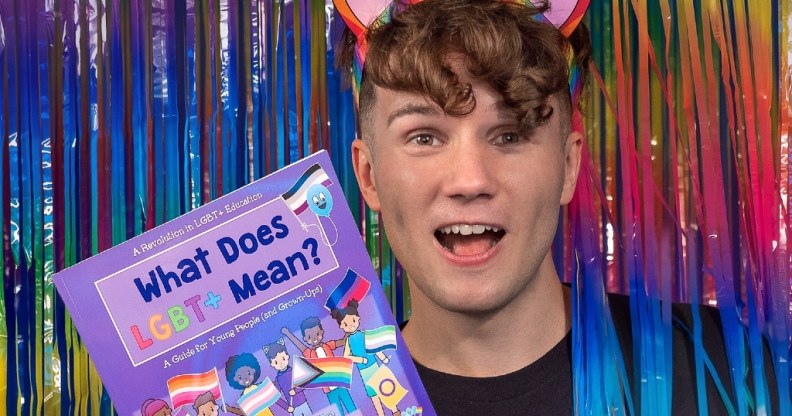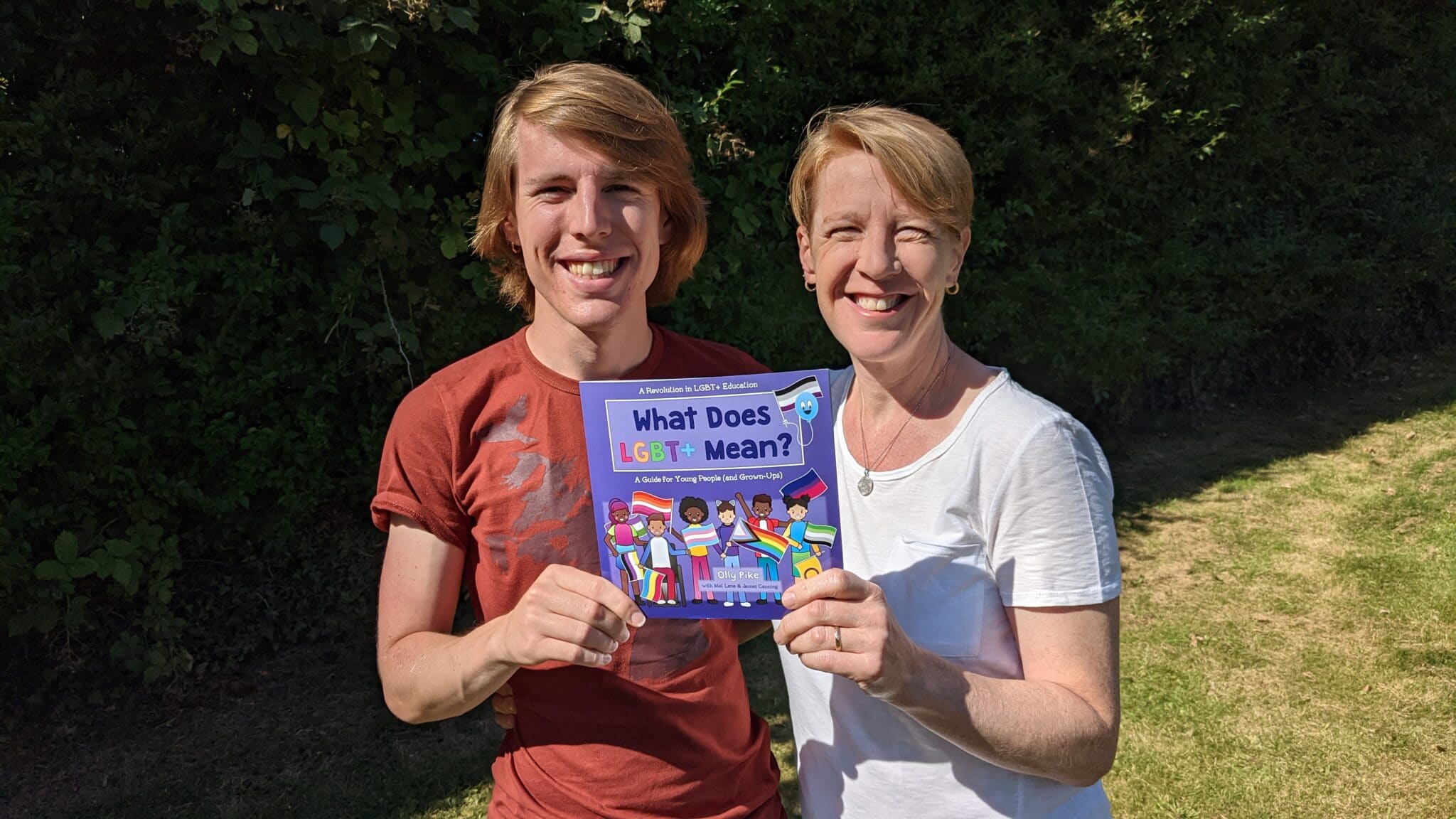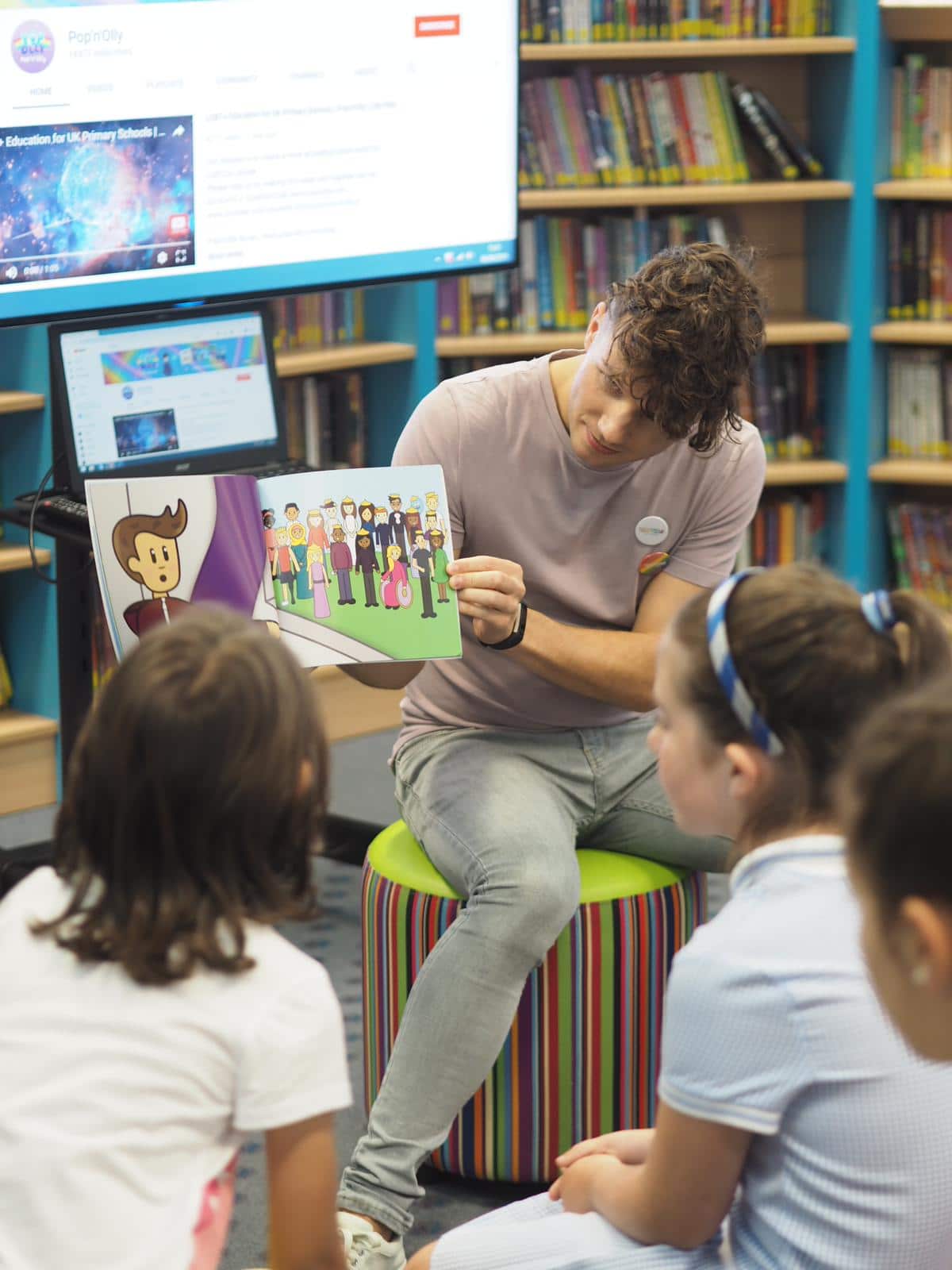Revolutionary new LGBT+ book for school kids hopes to nip prejudice in the bud

Pop’n’Olly founder Olly Pike posing with a copy of his new book. (Provided)
A powerful new book is aiming to stop children learning anti-LGBT+ prejudice by giving them the gift of education.
The book – titled What Does LGBT+ Mean? – A Guide for Young People (and Grown Ups) – is published by Pop’n’Olly, an educational resource for children.
The title, which is aimed at older primary school children, is billed as an “introductory guide” designed to help kids explore “identity, gender, love, sexual orientation, privilege, pride, discrimination, allyship and more”.
The 40-page education guide has been designed specifically to cater to teachers who might be feeling nervous about tackling LGBT+ identities among schoolchildren.
But the book’s authors also have a bigger goal – they want to stop children from learning anti-LGBT+ attitudes by providing them with a meaningful education.
In short, What Does LGBT+ Mean seeks to bring “inclusivity and inclusion” to the classroom, its authors explain.
LGBT+ inclusive education guide seeks to eliminate ‘learned’ homophobia in children
Olly Pike, director of Pop’n’Olly, wrote the book in conjunction with longtime primary school teacher Mel Lane and her son James Canning.
“The reason we wrote this book is that there isn’t a book that exists like this,” Pike tells PinkNews. “We know that LGBT+ bullying is the most common form of bullying found in UK schools. We know that LGBT+ young people are far more likely to self-harm and even attempt to take their own life, which is incredibly tragic.
“But the other thing we do know is that prejudice is learned, and I think this is about undoing LGBT+ prejudice before it can begin to form.”
Lane, who spent “many years” teaching primary school children, became “increasingly passionate about inclusivity and equality” in the lead-up to writing the new LGBT+ education guide.
“For the last couple of years I’ve been working with both teachers and young people, both primary and secondary, and what I’ve found is that teachers are really keen to talk about things but quite often they’re very nervous about using the wrong terminology, explaining things not correctly,” Lane says.

“With older children, they feel it’s something young people might know more about than them, that they feel out of their depth. We really wanted something that was aimed at key stage two children, so the eight to 11 bracket, but that will be useful for teachers to have confidence with them so they feel able to talk confidently and to introduce discussions in the classroom.”
The book – which has been trialled in real classrooms – is constructed to start conversations about LGBT+ identities in schools. It is also filled with questions about queerness to “get the children talking”, Lane says.
Pike, Lane and Canning were also really keen to make sure the explanations included in the book are “clear” and “accessible”.
“I really feel that there are many, many willing teachers but there just aren’t the resources out there,” Lane says.
“This goes very well with the current government guidelines on sex and relationships education, so schools are starting to think: ‘Oh gosh, we need to be talking about this.’
“Basically, we’re giving teachers everything to empower them to be able to introduce this conversation at a young age.”
Positive LGBT+ representation at an early age ‘can really make a difference’
Canning, who is just 24-years-old, came to the book for “personal reasons”. Having grown up in an era when homophobic bullying ran rampant in schools, he wants to make sure things are different for the next generation.
“My motivation was about providing something really positive for young LGBT+ people,” he says.
“Because when I was at school, nobody ever mentioned the word ‘gay’ in a positive way at all. It was never taught in classes, it was never mentioned by teachers, so the only time I ever heard it was when kids were saying something homophobic in lessons, in corridors, and teachers weren’t picking up on it.
“The image I got in my head is that being gay is this really bad thing, this really negative thing. I’m only ever hearing it in a negative way so there must be something really wrong with me. That was really hard for me for a period of time.”
With this book, Canning wanted to bring positive LGBT+ representation to children while also helping kids realise that anti-LGBT+ language isn’t acceptable.
“At that early age, it can really make a difference,” he says.
While the book is written by just three people, it was put together with vital contributions from people across the LGBT+ spectrum. Pike, Lane and Canning put together sections on intersex and trans identities in conjunction with people from those communities to make sure the end result is “appropriate for people with lived experiences”.
“We weren’t just getting one perspective, because we’re very conscious that there’s a huge diversity amongst LGBTQ people,” Lane says.
Pike, Lane and Canning were also aware of the potential for negative reactions to their educational guide – an LGBT+ inclusive programme for primary school children sparked protests in Birmingham in 2019, for example.
Despite this, Lane is expecting that the response will be largely positive – even if they do have a few detractors.

“There have been heads and teachers in my work that have been nervous about this, but the reality is that actually, the vast majority of parents are either supportive or they’re not bothered – they’re neutral,” Lane says.
“They’re kind of like: ‘That’s fine, that’s OK, that’s part of the school curriculum.’ And we also have parents who are like: ‘Thank you so much for doing this,’ because they see themselves represented. It’s not unusual now to talk with reception or year one children and for them to be very familiar with the fact that you can have two mums or two dads because someone in their class might have two mums or two dads.
“Children are more familiar with it than we give them credit for,” she adds.
“I think it’s important to say, we didn’t write the book worrying about whether parents would be stressing about it or not in mind. We wrote the book to create the most helpful book that we could for teachers and parents.
“We wrote the book that we felt was the best book.”
What Does LGBT+ Mean? Is published by Pop’n’Olly and is available to purchase through their website now. People can also donate a copy of the book to schools by visiting www.lgbteducation.co.uk.

